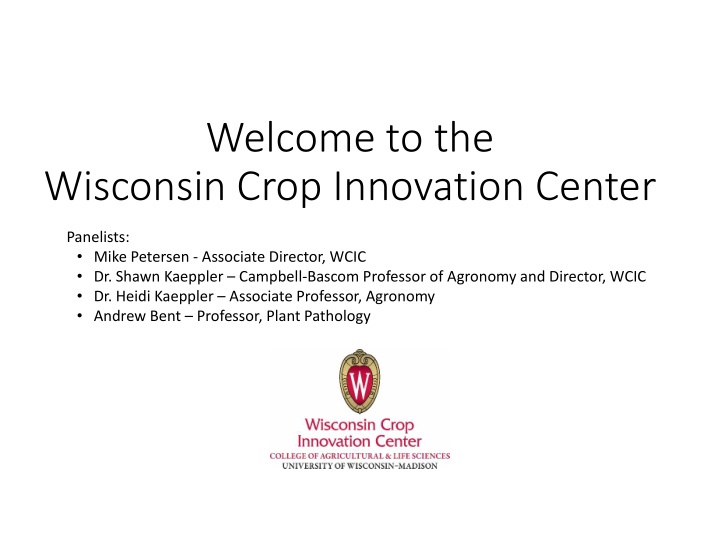



Welcome to the Wisconsin Crop Innovation Center Panelists: • Mike Petersen ‐ Associate Director, WCIC • Dr. Shawn Kaeppler – Campbell ‐ Bascom Professor of Agronomy and Director, WCIC • Dr. Heidi Kaeppler – Associate Professor, Agronomy • Andrew Bent – Professor, Plant Pathology
History of the Wisconsin Crop Innovation Center
1981 ‐ 1984 1981 • Cetus of Madison, Inc. opens with UW Bacteriology Professor Winston Brill as Director and WARF funding 1982 • Research focus was on isolating and characterizing Rhizobium species for better nitrogen fixation in soybean • WR Grace Co. purchases 51% equity and name changes to Agracetus • Research focus changes to plant transformation research and 1984 development
1985 ‐ 1990 Electric Gene Gun ‐ 1986 • Agracetus scientists invent the electric “Gene Gun” and begin to successfully transform many different plant species including tobacco, peanut, sunflower, soybean, maize, cotton, canola, poplar, wheat, rice, Tobacco among others • 1986 – 1 st field release of a GMO in the US (herbicide resistance in tobacco) • Transformation services contracted out to private companies (Monsanto, etc.)
1991 ‐ 1995 Handheld Gene Gun • Agracetus research continues in plant transformation and improving their gene gun techniques • DNA vaccine work initiated with a newly designed handheld gene gun • Contract work with Monsanto continues and leads to the Round ‐ up Ready Soybean event that is taken to market in 1996 as the first large scale, commercially successful transgenic plant sold on millions of acres across the US
1996 ‐ 2016 • Monsanto purchases Agracetus • Greenhouse and laboratory space is expanded • Research changes focus to Agrobacterium transformation and high throughput automation of the process • Site becomes the exclusive facility for all soybean, cotton, and canola transformation for Monsanto • Center of excellence for R&D activities including corn, wheat, rice, and alfalfa transformation, automation, gene expression, molecular testing, and seed chipping • In 2015, due to business consolidation, Monsanto generously donates the facility and much equipment to the UW ‐ Madison GFP Seed Chipping Gene Expression
2017 • Wisconsin Crop Innovation Center (WCIC) is born • Plant transformation and editing • Phenotyping • Research collaborations • Teaching/Education • Research & Development • Outreach
Mission, Business Model, Potential
Mission • The mission of WCIC is to advance basic and applied translational and functional genomic research in crop plants through technology development, collaboration, and fee ‐ for ‐ service transformation, gene ‐ editing, and phenotyping activities.
Business Model • Fee ‐ for ‐ service and collaborations • Grants for technology development • Partner with WARF on IP protection • Education and Outreach • Facility Use Agreements to support partnership with local business • e.g Middleton Spectral
WCIC will enable UW and U.S. public research
WCIC will enable Technology Transfer Technology Transfer Valley ‐ of ‐ Death
Thank you. Questions?
WCIC Genetic Engineering and Gene Editing Technologies for Crop Genomics Research and Genetic Improvement
Crop genetic engineering/editing applications • Study plant gene function and regulation • Introduce novel, useful traits • Improve current traits • Turn off negative traits
Examples of current and potential traits of engineered/edited crops • Enhanced yield of food, feed, fiber, biofuels with less inputs and reduced ecological footprint • Built-in disease, pest and stress resistance • Built-in herbicide resistance • Enhanced nutritional value or removal of “antinutritional or toxic compounds” • Reduced allergenicity • “Green” pharmaceutical production
Genome editing system for crop plants
Mechanisms of Resistance to Soybean Cyst Nematodes Andrew Bent University of Wisconsin - Madison TumblingRun / Flickr
Soybean cyst nematodes in soybean root (stained red with acid fuchsin) Photo: University of Missouri Extension
Soybean Cyst Nematode (SCN) is the most economically damaging pathogen or pest of soybean http://extension.entm.purdue.edu Photo: Kris Lambert • Widespread in U.S., Brazil, China • Inoculum pool only hatches gradually over a decade
Soybean Cyst Nematode Distribution 1957 - 2014 1957 1973 1980 1990 2001 2014 Figures adapted from “ Increased Reproduction of Soybean Cyst Nematode and Yield Of SCN - Resistant Soybean Varieties” – Greg Tylka, Iowa State
Syncytium: Biotrophic Interface for 3-4 Weeks
Rhg1 is a ~30kb block containing 4 ORFs: 2580, 2590, 2600 and 2610 Three of the gene products contribute to resistance 31.2 kb Susceptible Varieties: Rhg1 block present in one copy Resistant Varieties: Rhg1 block present in multiple tandem repeat copies
SCN Resistance: Slow Erosion Partial breakdown of PI88788 resistance PI 88788 Zheng and Chen. Journal of Ent. and Nem. 2011 8
Towards the identification of novel soybean cyst nematode resistance genes UC Davis Katelyn J. Horgan | Ph.D. Candidate
Stacking G. soja QTL L. Brzostowski & B. Diers, unpublished Rhg1 cqSCN006 cqSCN007 Chr 10 No QTL Rhg1 + cqSCN006 + cqSCN007 + Chr 10
cqSCN007 Chr. 18 146 kb 1 1
CRISPR/Cas9 to mutate targeted genes 1 2
Thank You! Funding: United Soybean Board USDA-NIFA APS/Pioneer & NSF Fellowships
Recommend
More recommend